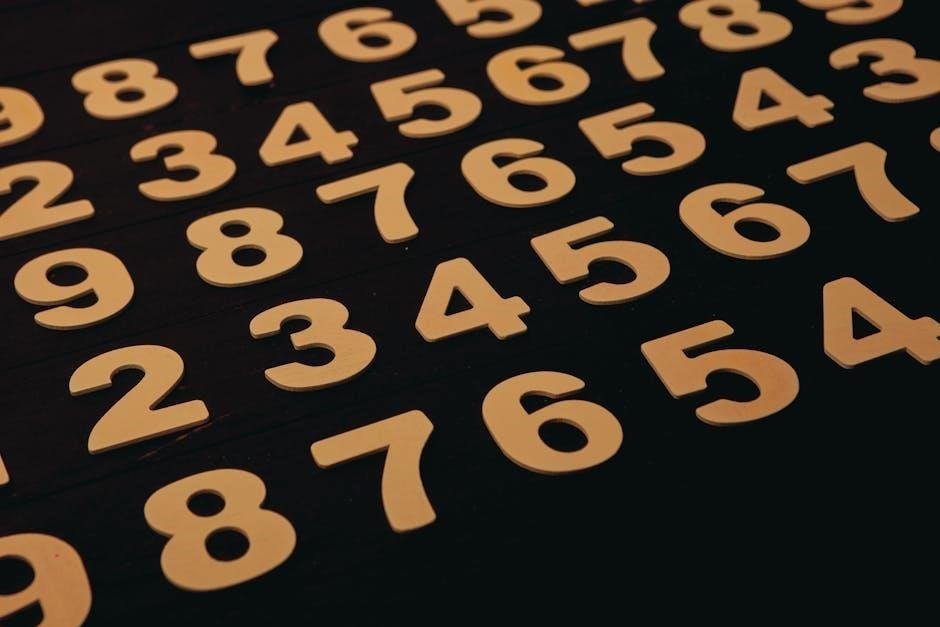An arithmetic sequence is a sequence of numbers with a constant difference between consecutive terms, known as the common difference. Worksheets provide structured practice.
1.1 Definition and Basic Concepts
An arithmetic sequence is a sequence of numbers where each term after the first is obtained by adding a constant value, known as the common difference, to the preceding term. The general form is a, a + d, a + 2d, …, where a is the first term and d is the common difference. Worksheets often include exercises to identify these elements and apply them to real-world problems.
1.2 Importance of Arithmetic Sequences in Mathematics
Arithmetic sequences are fundamental in mathematics, serving as a building block for understanding more complex concepts like series, patterns, and linear relationships. They are essential in problem-solving, algebra, and real-world applications such as finance, science, and engineering. Mastering arithmetic sequences enhances logical thinking and analytical skills, making them a critical component of early math education. Worksheets provide practical exercises to reinforce these concepts.
Key Formulas and Terminology
The explicit formula for the nth term is aₙ = a₁ + (n-1)d, where a₁ is the first term and d is the common difference. The sum of the first n terms is Sₙ = n/2 (a₁ + aₙ).
2.1 Explicit Formula for the nth Term
The explicit formula for the nth term of an arithmetic sequence is given by aₙ = a₁ + (n-1)d, where a₁ is the first term, d is the common difference, and n is the term number. This formula allows direct calculation of any term in the sequence without needing to list all previous terms.
For example, to find the 10th term, substitute n = 10 into the formula: a₁₀ = a₁ + (10-1)d.
2.2 Common Difference and Its Role
The common difference (d) is the constant value added to each term to get the next term in an arithmetic sequence; It is calculated by subtracting any term from the next term. A positive d indicates an increasing sequence, while a negative d indicates a decreasing sequence. The common difference is essential for defining the sequence’s behavior and calculating terms.
2.3 Sum of the First n Terms
The sum of the first n terms of an arithmetic sequence is calculated using the formula Sₙ = n/2 × (a₁ + aₙ), where a₁ is the first term and aₙ is the nth term. This formula derives from the average of the first and last term, multiplied by the number of terms. It is essential for solving problems involving cumulative values in sequences.
Finding the Common Difference
The common difference is found by subtracting consecutive terms in an arithmetic sequence. Worksheets often include exercises to identify and calculate this key value, ensuring understanding of its role in sequence behavior and formula derivation.
3.1 Identifying the Common Difference in a Sequence
The common difference in an arithmetic sequence is identified by subtracting any term from the next term. Worksheets often provide sequences like 12, 16, 20, where the difference is 4. This consistent subtraction method helps in recognizing patterns and understanding the fundamental property of arithmetic sequences. Regular practice with such exercises enhances problem-solving skills and conceptual clarity.
3.2 Examples of Calculating the Common Difference
Worksheets provide clear examples for calculating the common difference. For instance, in the sequence 12, 16, 20, the common difference is found by subtracting 12 from 16, resulting in 4. Similarly, in the sequence 8, 13.8, the difference is 5.8. These exercises help students master the concept and apply it to various problems, ensuring a strong understanding of arithmetic sequences.

Writing the Explicit Formula
The explicit formula for an arithmetic sequence is aₙ = a₁ + (n ⎻ 1)d, where a₁ is the first term and d is the common difference. To derive it, identify a₁ and d from given terms, then substitute into the formula. This allows calculation of any term in the sequence efficiently, making it a powerful tool for understanding arithmetic sequences.
4.1 Deriving the Formula from Given Terms
To derive the explicit formula, identify the first term (a₁) and the common difference (d) from the given sequence. Use the formula aₙ = a₁ + (n ⎻ 1)d. For example, if the first term is 5 and d = 3, the formula becomes aₙ = 5 + (n ⏤ 1) × 3. This process allows you to express the nth term directly, ensuring clarity and precision in calculations.
4.2 Practice Problems for Writing the Explicit Formula
Practice problems help reinforce understanding of explicit formulas. For example, given the sequence 5, 8, 11, 14…, identify the first term (a₁ = 5) and common difference (d = 3), then write the formula: aₙ = 5 + (n ⏤ 1) × 3. Worksheets often include varied sequences to test proficiency in deriving formulas accurately and efficiently.
Finding Specific Terms in an Arithmetic Sequence
Finding specific terms involves using the explicit formula. Given the first term and common difference, you can calculate any term in the sequence, such as the 10th or 52nd term, by plugging the values into the formula aₙ = a₁ + (n ⏤ 1)d.
5.1 Calculating the 10th Term
To find the 10th term of an arithmetic sequence, use the explicit formula: a₁₀ = a₁ + (10 ⎻ 1)d. Plug in the first term (a₁) and the common difference (d) to calculate the value. For example, if a₁ = 2 and d = 3, then a₁₀ = 2 + (9)(3) = 29. This method ensures accuracy in determining specific terms within the sequence.
5.2 Finding the 52nd Term
To determine the 52nd term of an arithmetic sequence, apply the explicit formula: aₙ = a₁ + (n ⏤ 1)d. Substitute n = 52, the first term (a₁), and the common difference (d). For example, if a₁ = 32 and d = 20, then a₅₂ = 32 + (52 ⎻ 1) * 20 = 32 + 1020 = 1052. This method allows precise calculation of distant terms in the sequence.

Arithmetic Sequence Worksheets
Arithmetic sequence worksheets offer structured exercises, including finding common differences, writing explicit formulas, and calculating specific terms. Available as downloadable PDFs, they provide convenient practice resources for students.
6.1 Benefits of Using Worksheets for Practice
Worksheets provide structured practice for mastering arithmetic sequences, reinforcing concepts like common differences and explicit formulas. They offer a clear format for problem-solving, making learning systematic and organized. Regular practice with worksheets helps build confidence and fluency in handling sequence problems, ensuring a strong foundation in arithmetic sequences.
6.2 Downloadable PDF Resources
Downloadable PDF worksheets offer convenient and accessible practice materials for arithmetic sequences. These resources are freely available and cover various topics, from finding common differences to calculating specific terms. They provide structured exercises with clear examples, making them ideal for self-study or homework. PDFs ensure that students can practice systematically, reinforcing their understanding of arithmetic sequences anytime, anywhere.

Solving Arithmetic Sequence Problems
Solving arithmetic sequence problems involves finding terms, common differences, or explicit formulas. Worksheets provide practice in identifying patterns and applying formulas to real-world scenarios, enhancing problem-solving skills.
7;1 Determining the First Five Terms
Determining the first five terms of an arithmetic sequence involves using the common difference and the starting term. For example, given a starting term and the common difference, each subsequent term is calculated by adding the difference to the previous term. Worksheets often provide problems where students can practice this process, ensuring a strong foundation in sequence fundamentals. This skill is essential for solving more complex arithmetic sequence problems.
7.2 Solving for the General Term
Solving for the general term involves using the explicit formula ( a_n = a_1 + (n-1)d ). Given the first term ( a_1 ) and the common difference ( d ), you can find any term in the sequence; Worksheets often provide problems where students can practice deriving the formula from given terms, ensuring mastery of arithmetic sequence fundamentals. This concept is crucial for solving more complex sequence-related problems.

Real-World Applications of Arithmetic Sequences
Arithmetic sequences are used in financial planning, budgeting, and science. They model regular payments, population growth, and structural engineering problems, providing practical solutions in diverse fields.
8.1 Financial Planning and Budgeting
Arithmetic sequences are invaluable in financial planning and budgeting. They help model regular payments, such as monthly installments or investments, by calculating future values based on consistent increments. For example, savings plans or mortgage payments often rely on arithmetic sequences to determine how much to set aside each period. This structured approach aids in forecasting and ensuring financial stability over time.
8.2 Applications in Science and Engineering
Arithmetic sequences are fundamental in scientific and engineering applications, such as calculating uniform motion, signal processing, and structural analysis. They model phenomena like equally spaced intervals in physics or consistent material properties in engineering. For instance, in electronics, timing circuits rely on arithmetic sequences to generate evenly spaced signals, ensuring system reliability and precision.
Advanced Topics in Arithmetic Sequences
Exploring recursive formulas and advanced sum calculations enhances understanding of arithmetic sequences, offering deeper insights into their structure and practical applications in mathematics.
9.1 Recursive Formulas
Recursive formulas define each term of an arithmetic sequence based on the previous term, using the common difference. For example, aₙ = aₙ₋₁ + d. This approach is useful for generating terms step-by-step; Worksheets often include exercises to practice writing and applying recursive formulas, helping students understand how each term relates to the sequence’s progression.
9.2 Sum of the First n Terms
The sum of the first n terms of an arithmetic sequence can be calculated using the formula Sₙ = n/2 × (a₁ + aₙ) or Sₙ = n/2 × [2a₁ + (n ⏤ 1)d]. This concept is crucial for understanding the cumulative behavior of sequences. Worksheets often include problems that require calculating the sum, reinforcing the relationship between terms and their progression.
Tips for Creating Effective Worksheets
Ensure clarity by using straightforward language and structured problems. Incorporate visual aids and examples to enhance understanding. Provide varied exercises to cover different aspects of arithmetic sequences.
10.1 Designing Clear and Concise Problems
Use simple language and focus on specific skills, such as finding the common difference or writing explicit formulas. Include a mix of straightforward and challenging questions. Provide clear instructions and examples to guide students. Ensure problems are visually organized to avoid confusion. Regularly review and update worksheets to keep content relevant and engaging for learners.
10.2 Incorporating Visual Aids
Use tables, charts, and graphs to illustrate arithmetic sequences. Include examples of sequences with highlighted common differences. Add number lines to show term progression visually. Incorporate diagrams to explain formulas, such as the nth term formula. Visual aids simplify complex concepts and help students recognize patterns, making learning more engaging and accessible for different learning styles.

Common Mistakes to Avoid
Common errors include misapplying the explicit formula and incorrectly calculating the common difference; Students often confuse terms or misidentify the sequence pattern, leading to incorrect solutions.
11.1 Misapplying the Explicit Formula
A common mistake is incorrectly applying the explicit formula for the nth term, often due to misidentifying the first term or the common difference. For instance, confusing the term number with its position or incorrectly substituting values leads to errors. Ensure the formula ( a_n = a_1 + (n ⏤ 1)d ) is applied accurately to avoid miscalculations in arithmetic sequence problems.
11.2 Incorrect Calculation of the Common Difference
A common error is miscalculating the common difference by incorrectly subtracting consecutive terms or misapplying the formula. Ensure the difference is consistent by subtracting the first term from the second term accurately. For example, in the sequence 12, 16, 20, the common difference is 4, not 8. Always verify calculations to avoid incorrect results in arithmetic sequences.

Assessing Understanding
Assessing understanding involves evaluating students’ grasp of arithmetic sequences through quizzes, tests, and assignments. These tools help measure their ability to apply formulas and solve problems effectively.
12.1 Quiz and Test Ideas
Quizzes and tests can include multiple-choice questions, fill-in-the-blanks, and problem-solving tasks. Examples include identifying the common difference, writing explicit formulas, and calculating specific terms. Mid-term exams might focus on finding the 10th or 52nd term, while final tests could cover sum of terms, recursive formulas, and real-world applications. Downloadable PDF worksheets provide excellent practice materials for these assessments.
12.2 Grading Rubrics for Worksheets
Grading rubrics for arithmetic sequence worksheets should assess accuracy, completeness, and understanding. Criteria may include identifying the common difference, writing explicit formulas, and calculating terms correctly. Points can be deducted for errors in calculations or misapplying concepts. Rubrics should be clear and consistent, ensuring fairness in evaluation. Instructors can provide feedback to guide improvement and clarify expectations for future assignments.
Mastery of arithmetic sequences is essential for mathematical proficiency. Regular practice with worksheets enhances understanding and problem-solving skills. Encourage learners to explore further and refine their techniques consistently.
13.1 Summary of Key Concepts
An arithmetic sequence is a sequence where each term increases by a constant difference. The nth term is given by (a_n = a_1 + (n-1)d), where (a_1) is the first term and (d) is the common difference. Worksheets provide essential practice for finding terms, common differences, and sums, reinforcing understanding of these fundamental concepts.
13.2 Encouragement for Further Practice
Consistent practice with arithmetic sequences is key to mastering the concept. Utilize downloadable PDF worksheets to reinforce understanding and improve problem-solving skills. Regularly challenging yourself with various problems will build confidence and fluency. Explore interactive resources and advanced topics to deepen your knowledge and stay motivated in your mathematical journey.